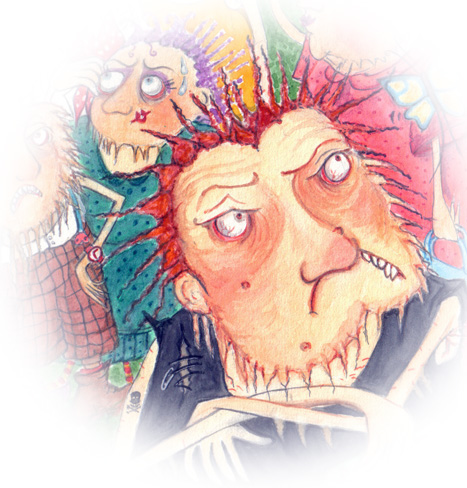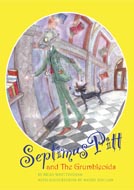

Contents
Septimus Pitt
(poem)The Grumbloid Rap
(poem)Notes for Teachers
(About the book)Gathering Thoughts
(some ideas for using
the Worksheets)Worksheet 1
(The Cosmic Postman -
Outer Space)Worksheet 2
(Michael and Billy -
Anti-sectarianism)
Back
to Brian Whittingham's
website
FOR TEACHERS
First and foremost this is a poetry collection with illustrations. One that encourages P5s - young adults, to read and enjoy poetry. But it can also be used as a teaching resource, (refer to the Task Stimulus Worksheets). The following shows what I had in mind when pulling these poems and illustrations together and why I am making the distinction between poetry and resource.
Over
recent years I've worked in primary and secondary schools and also in the further
education sector, teaching creative writing and literacy. I've worked with children
and adults of varying abilities, giving students and pupils, various tasks and
stimuli to encourage them to not only write but to write creatively.
After
looking at the various age groups and their engagement / non-engagement, with
language, it became obvious to me that when the primary pupils were given tasks,
in general they had a connection with language and creativity that encouraged
them to engage with these tasks. This engagement, for various reasons, seems to
lessen dramatically when they move on to secondary, then adulthood.
It's
obvious that we must engage our readers and writers when they are young and endeavour
to stimulate them to maintain that engagement into their adult years.
A philosopher once asked the question: "If we didn't have any sensory experience of the world, would we have a thought in our head?" He was arguing on the premise that all thought is a result of sensory experience. If this is the case, then if a writer captures sensory experience that in turn is exposed to the reader; the reader will be engaged. There are many sides to this debate but nevertheless there's no denying the link with sensory experience and engagement.
I've noticed that by far the most engaging creative writing element is sensual imagery and if pupils and students can recognise this, then they can begin to engage readers into their created world, and also they then recognise themselves, that when they read writing written in this manner, they can receive stimulation and most importantly connect with the enjoyment of reading.
The poems in this collection have been written, in the main using sensory imagery, and chronologically ordered, content wise and stylistically, to initially engage and encourage readers when they are at the upper primary stage then laterally to maintain that engagement and stimuli into their becoming young adults.
The use of illustrations is intrinsic in the book's structure, as they not only complement the words but also engage the readers, being a medium other than words, with elements of puzzle that ensure the reader looks closer and therefore absorbs the imagery on a word level and on a picture level. A cross fertilisation of stimulus is the result.
The sample
Task Stimulus Worksheet represents
a workshop template that can be used to explore the subjects covered in the poems
and illustrations where students can discuss, draw, write and take part in drama
improvisation.
A book to engage the child, the adult within the child,
the child within the adult and also the adult, that's the goal of this collection
that hopefully can be shared by children of all ages.
Brian Whittingham
The
book, Septimus Pitt, is due to be published by Luath
Press and launched in Feb. 2007 at the
AYE
WRITE LITERARY FESTIVAL in the Mitchell library.
